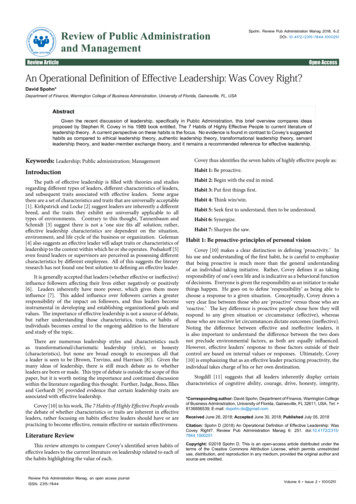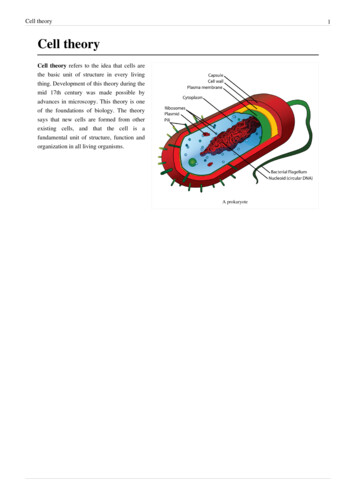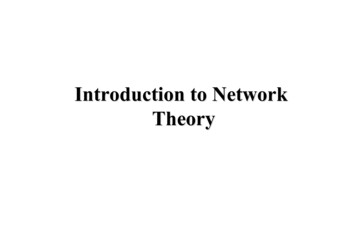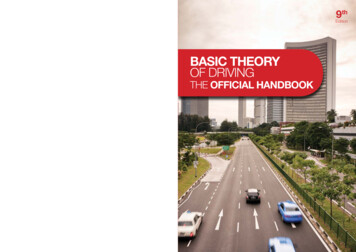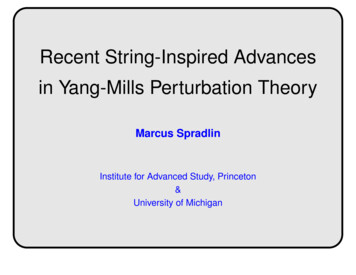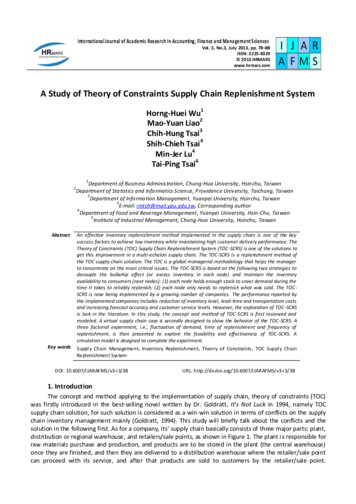
Transcription
International Journal of Academic Research in Accounting, Finance and Management SciencesVol. 3, No.3, July 2013, pp. 78–88ISSN: 2225-8329 2013 HRMARSwww.hrmars.comA Study of Theory of Constraints Supply Chain Replenishment SystemHorng-Huei Wu1Mao-Yuan Liao2Chih-Hung Tsai3Shih-Chieh Tsai4Min-Jer Lu4Tai-Ping Tsai612AbstractKey wordsDepartment of Busin ess Administra tion, Chung-Hua University, Hsin chu, TaiwanDepartment of Statistics and Info rmatics Scien ce, Providence University, Taichung, Taiwan3Department of Info rmation Managemen t, Yuanpei University, Hsin chu, Taiwan3E-mail: imtch@mail.ypu.edu.tw, Co rresponding author4Department of Food and Beverage Management , Yuanpei University, Hsin-Chu, Taiwan5Institute of Industrial Management, Chung-Hua University, Hsinchu, TaiwanAn effective inventory replenishment method implemented in the supply chain is one of the keysuccess factors to achieve low inventory while maintaining high customer delivery performance. TheTheory of Constraints (TOC) Supply Chain Replenishment System (TOC-SCRS) is one of the solutions toget this improvement in a multi-echelon supply chain. The TOC-SCRS is a replenishment method ofthe TOC supply chain solution. The TOC is a global managerial methodology that helps the managerto concentrate on the most critical issues. The TOC-SCRS is based on the following two strategies todecouple the bullwhip effect (or excess inventory in each node) and maintain the inventoryavailability to consumers (next nodes): (1) each node holds enough stock to cover demand during thetime it takes to reliably replenish; (2) each node only needs to replenish what was sold. The TOCSCRS is now being implemented by a growing number of companies. The performance reported bythe implemented companies includes reduction of inventory level, lead-time and transportation costsand increasing forecast accuracy and customer service levels. However, the exploration of TOC-SCRSis lack in the literature. In this study, the concept and method of TOC-SCRS is first reviewed andmodeled. A virtual supply chain case is secondly designed to show the behavior of the TOC-SCRS. Athree factorial experiment, i.e., fluctuation of demand, time of replenishment and frequency ofreplenishment, is then presented to explore the feasibility and effectiveness of TOC-SCRS. Asimulation model is designed to complete the experiment.Suppl y Chain Mana gement, Inventory Replenishment, Theory of Constraints , TOC Suppl y ChainReplenishment Sys temDOI: 10.6007/IJARAFMS/v3-i 3/38URL: http://dx.doi.org/10.6007/IJARAFMS/v3-i 3/381. IntroductionThe concept and method applying to the implementation of supply chain, theory of constraints (TOC)was firstly introduced in the best-selling novel written by Dr. Goldratt, It’s Not Luck in 1994, namely TOCsupply chain solution, for such solution is considered as a win-win solution in terms of conflicts on the supplychain inventory management mainly (Goldratt, 1994). This study wil l briefly talk about the conflicts and thesolution in the following first. As for a company, its’ supply chain basically consists of three major parts: plant,distribution or regional warehouse, and retailers/sale points, as shown in Figure 1. The plant i s responsible forraw materials purchase and production, and products are to be stored in the plant (the central warehouse)once they are finished, and then they are delivered to a distribution warehouse where the retailer/sale pointcan proceed with its service, and after that products are sold to customers by the retailer/sale point.
International Journal of Academic Research in Accounting, Finance and Management SciencesVol. 3 (3), pp. 78–88, 2013 HRMARSGenerally, a distribution/regional warehouse is a company-owned branch, but not necessarily for retailer/salepoint. But regardless whether members of these three parts belong to the same company, the so-calledefficient “sales” must be the products sold to the main customers by the retailer/sale points to be consideredas the real sales, otherwise they are just the inventory within the supply chain (even they are noted to be soldto downstream companies, chances that the surplus inventory may be returned still exist).Sale egionalWarehouse‧‧‧RegionalWarehouseSale pointFigure 1. The network graph of supply chainIn terms of the maximized profit on the supply chain, we must first ensure the main customers are ableto purchase goods they desired, and in order to avoid the main customers being unable to buy goods theywish to have, we must place the inventory at places where can reach them easily (such as retailers/salepoints), and to prepare as large inventory as possible in order to meet the peak of demand that may occuroccasionally, as shown in Figure 2. In other words, factories should produce products and deliver them to theretailer/sale point as fast as they could in order to meet the main customers’ needs, as shown in the upperpart of Figure 2. However in the current market that is intense and competitive, customer requirements aregetting harsher and harsher and the product life cycle is unable to grasp, in order to avoid large inventoriescausing loss and damages (such as products being returned due to decreasing sales, waste, specifications orquality failed to meet the requirements, etc), therefore inventories must be stored at the sources of places(namely factories), and to deliver the smallest inventory to the retailer/sale point in order to prevent loss dueto demand changes in the market. In other words, the plant shall try its best to delay production and delivery,and deliver its smallest inventory to the retailer/sale point, as shown in the lowe r part of Figure 2. Hence theconflict graph shown in Figure 2 shows the two difficulties and conflicts the supply chain management andinventory management within each sale point confronts.To ensure tha t cus tomerscan buy the productsthey wantPreparation of alarger inventorySuccessfulsupply chainmanagementReduce the too highrisk of supply chaininventoryPreparation of afewer inventoriesFigure 2. The conflict graph of supply chain management (Goldratt, 1994)79
International Journal of Academic Research in Accounting, Finance and Management SciencesVol. 3 (3), pp. 78–88, 2013 HRMARSGenerally in the face of the conflict on the supply chain, it is an ability to enhance the responsecapability of supply chain via a technology aiming at strengthening the market forecast and speed ofinformation feedback, for example, to push the original plant prediction forward into the management modeof retailer/sale point, and then change it into the retailer prediction, and again to move to the managementmode of plant cargo through rapid information response. Although such change can mitigate the abovementioned conflict, but the conflict itself is remained unsolved, and even can get worse. For example, theaccuracy of a retailer’s forecast of future sales is found to be lower than that of a distribution warehouse’sforecast, and it is due to the sales of distribution warehouse is the sum of sales of sale points, and hence theaccuracy is no doubt to be higher than individual forecast conducted by each sale point; likewise plant sales isthe sum of all distribution warehouse sales, therefore the accuracy on overall sales forecast conducted by theplant is of course higher than the forecast of each distribution warehouse sales. In this conflict, its very natureis not to determine which forecast is better than others (please note that forecast itself consists of risks and itis not always reliable), but it is about the inventory should be placed within the supply chain, as well as howeach sale point deals with its replenishment, accounted for the reasonable issues. Therefore, the TOC hasproposed the following solutions accordingly:(1) The inventory should be placed within the source of supply chain (namely the plant). Therefore donot deliver the products to the downstream companies right away by the time they are fini shed; anddistribution warehouses should not deliver the products to the downstream companies as soon as productsfrom upstream companies arrived.(2) Each sale point only needs to store enough inventory needed for such replenishment period. Forexample, if it takes three days for replenishment and according to the previous sales record, the maximumdemand for consecutive three days is 300, and then there should be only 300 in the sale point’s inventory.(3) Each sale point should make up the replenishment in accordance with its sales, by replenishing howmuch it has sold.(4) To monitor the sudden abnormal condition via the Buffer Management (BM) mechanism in order toprepare for any contingency. Such as the sudden increase in the sales resulting in low inventories, then BMcan detect it right away and send out a signal for replenishment need.The above is the main content of the theory of constraints in terms of the supply chain solution. Amongwhich the first point belongs to the new theory of supply chain manageme nt, and the second and third pointsare referred to a brand new inventory replenishment mechanism, namely the TOC supply chainreplenishment system (TOC-SCRS), and as for the fourth point, it is the monitoring mechanism of inventory.The focus of this study lies in the discussion of TOC-SCRS; therefore, regarding the TOC-SCRS implementation,please refer to the related documents (Holt, 1999; Perez, 1997; Simatupang et al., 2004; Smith, 2001; Yuan etal., 2003).Under the TOC-SCRS mechanism, each sale point has stored the largest inventory that was occurredduring the replenishment period, and the volume lies in the sales quantity between the two replenishmentperiods, hence we can be certain that the sale point has the lowest inventory. And under the BM mechanism,impacts caused by unexpected situations are to be determined, and request of emergency replenishment willbe alerted if necessary, as a result, out of stock can be avoided. According to common reactions of variouscompanies (Belvedere and Grando, 2005; Blackstone, 2001; Hoffman and Cardarelli, 2002; Novotny, 1997;Patnode, 1999; Sharma, 1997; Waite et al., 1998; Watson and Polito, 2003) towards the TOC-SCRS, the benefitlies in the reduction of inventory substantially, enhancement of service quality, reduction in expired products(or reduction in the out rate), and more rapid reaction in terms of market changes, etc. However, theexploration of TOC-SCRS is lack in the literature. In this study, the concept and method of TOC-SCRS is firstreviewed and modeled. A virtual supply chain case is secondly designed to show the behavior of the TOC SCRS. A three factorial experiment, i.e., fluctuation of demand, time of replenishment and frequency ofreplenishment, is then presented to explore the feasibility and effectiveness of TOC-SCRS. A simulation modelis designed to complete the experiment.80
International Journal of Academic Research in Accounting, Finance and Management SciencesVol. 3 (3), pp. 78–88, 2013 HRMARS2. The Model of TOC-SCRSFigure 3 shows the basic concept of TOC-SCRS. This mechanism explains the replenishment mechanismthat each sale point (namely plant, warehouse, or retailer) in the supply chain must be applied to (Cole andJacob, 2002; Wu et al., 2010; Wu et al., 2011), and under the circumstances that sales of each period (thedaily or weekly sales of a sale point or the sum of total demand or total purchase from the downstreamcompanies) is determined, such mechanism contains three kinds of parameters, they are respectively thereplenishment time, maximum inventory level, and replenishment quantity, details are described in thefollowing:Demand ofdownstreamReplenishment timeDemand(TRR FR RRT)DemandCentralwarehouseDemandDemand ofdownstreamDemand ofdownstreamRegionalDemandWarehouseBuffer LevelDemand ofdownstreamMa xi mum demand of ea ch phase (D)TRR(ri) Time to Reliably Replenish for product i.; RRT(li) Reliable Replenishment Time for product i.FR(fi) Frequency of Replenishment (FR) for product i.Figure 3.The replenishment mechanism of TOC-SCRS (Cole and Jacob, 2002)(1) Replenishment time: The sum of replenishment frequency and the lead time it requires.。Replenishment frequency is the how long to replenish once, which is the time interval from theprevious replenishment order to the current replenishment order.。Replenishment lead time: How long does it take from replenishment order is released until productsare delivered to the destination, and such time may include the production time the upstream companiesneed, or the delivery time between downstream companies and the sale point, etc.(2) Maximum inventory level: The maximum inventory quantity within consecutive replenishment timeis estimated in accordance with the length of replenishment time based on the record of the previous sales.For example, if the replenishment time is 3 days, and the maximum value of the consecutive 3-day salesaccording to the previous sales record is defined as the maximum inventory quantity of the sale point. Inother words, the maximum inventory quantity is determined in accordance with the replenishment time andprevious sales, therefore the relationship can be presented in the following formula (1), and the detailedformula and application example will be shown in Figure 4.Maximum inventory quantity f (replenishment time, sales of each phase)(1)81
International Journal of Academic Research in Accounting, Finance and Management SciencesVol. 3 (3), pp. 78–88, 2013 HRMARSFigure 4.The Model of Buffer Level(3) Replenishment quantity: The volume of each replenishment order is the total sales of the sale pointfrom the previous replenishment order to the current replenishment order, namely to replenish how much isused, for example, if the replenishment frequency is once in two days, and then the replenishment quantity isthe sales of the recent two days. In other words, the replenishment quantity is determined by thereplenishment frequency and the sales within the period, therefore the relationship can be presented in thefollowing formula (4), and the detailed formula and application example will be shown in Figure 5.Replenishment quantity f (replenishment frequency, sales of each phase)82(4)
International Journal of Academic Research in Accounting, Finance and Management SciencesVol. 3 (3), pp. 78–88, 2013 HRMARSFigure 5. The Model of Replenishment QuantityAmong the above three parameters, the replenishment time and replenishment frequency must bedetermined in accordance with needs by the user, but TOC stresses that unless environmental and technicalconstraints are found, such as sailing schedule or route change, otherwise the shorter the replenishmentfrequency the better the performance (like one day). As for the maximum inventory level and replenishmentquantity, are determined by the known demand of each phase and replenishment time (frequency).Secondly, in terms of impacts caused by unexpected situations, the TOC-SCRS couples with the BMmechanism system. The BM is basically an inventory monitoring mechanism that is applied to each sale point,mainly aiming at monitoring the impacts caused by unexpected situations in the supply chain, such as thedelay of trucks or sudden increase in sales, etc, for it is as well an estimation method for evaluating the level83
International Journal of Academic Research in Accounting, Finance and Management SciencesVol. 3 (3), pp. 78–88, 2013 HRMARSof impact. Its concept of application is similar to the buffer management mechanism collocated with theproduction management and drum-buffer-rope (DBR) (Schragenheim and Ronen, 1991). However, the buffermanagement mechanism that goes along with the DBR is the buffer time, but over here what the buffermanagement mechanism monitors in terms of inventory is the inventory quantity. A buffer managementmechanism of monitoring is needed for each commodity and the size of the largest buffer (inventory) is themaximum inventory level, the three areas represent the three inventory monitoring areas, derived from themaximum inventory level division, and they are respectively the action, warning, and safe areas. When theinventory is more than 2/3 (inclusive) of buffer, it means the stock is abundant, for we do not need to payattention, thus such area is called the safe area; when the inventory is more than 1/3 (inclusive) or less than2/3 of buffer, it means the stock is not very abundant, for it is not up to the state of shortage, hence we onlyneed to be alerted and pay attention to the subsequent changes, no actions are needed to be done so far,hence this area is called the warning area; when the inventory is consumed fully and less than 1/3 of buffer, itmeans it may be out of stock at any time, so we must immediately request an emergency replenishment fromupstream companies, hence this area is called the action area. Through the buffer management monitoringmechanism of inventory, unexpected situations or variations that may cause a shortage can be avoided.3. Characteristics and Problems of the TOC-SCRSAccording to the above descriptions, the TOC-SCRS basically contains the following characteristics:(1) In general, according to the inventory theory, the inventory mechanism is divided into successive(or quantitative) replenishment, such as (s, S), and fixed period replenishment, such as (R, S) (Silver et al.,1998), and so, the TOC-SCRS is considered as a fixed period replenishment method.(2) The determination of TOC-SCRS replenishment quantity and maximum inventory level varies fromthe general fixed period replenishment method. The general fixed period replenishment methods, such as (R,S) or (R, Q), the replenishment quantity (Q) and the maximum inventory level (S) are determined by EconomicOrder Quantity (EOQ), Q EOQ or S s EOQ (Silver et al., 1998). Therefore, the replenishment frequency andthe length of replenishment time have no direct impacts on the replenishment quantity or the maximuminventory level. As for the replenishment quantity of TOC-SCRS, it is determined by the replenishmentfrequency and the sales between two replenishment periods, it is similar to Lot-for-Lot (L4L) of materialrequirement planning (MRP), hence the shorter the replenishment frequency, the smaller the replenishmentquantity. And the maximum inventory level is determined by the replenishment time and sales within suchtime, hence the shorter the replenishment time, the smaller the maximum inventory level. In other words,the length of replenishment frequency and replenishment time is the key factor to determine thereplenishment quantity and the maximum inventory level of TOC-SCRS. This point (how it determines thereplenishment quantity and the maximum inventory level) shows the biggest difference in the TOC -SCRScompared to general fixed period replenishment mechanisms.(3) Because the replenishment quantity and the maximum inventory level of TOC-SCRS are determinedby the replenishment frequency and replenishment lead time; therefore, how managers control the inventorylevel and make adjustments in accordance with changes in sales is more direct and more efficient. And as longas we can improve the replenishment frequency and replenishment time, the inventory level can thus bereduced, and most importantly, we may avoid shortages caused by lower inventories. This is one of thereasons why the TOC-SCRS is widely accepted by practitioners.(4) Will the number and cost of delivery increase followed by the reduction in the replenishmentquantity? According to the actual case report (Kendall, 2006), there will not be any increases. A delivery of 10commodities, 50 of each (three-month supply) and a delivery of 50 commodities, 10 of each (three-weeksupply), both shares the same delivery frequency, hence no extra delivery frequency or cost will be occurred.Due to the key determinant of the replenishment quantity and the maximum inventory level of TOCSCRS lies in the length of replenishment frequency and replenishment time, and such characteristic (how itdetermines the replenishment quantity and the maximum inventory level) explains how the TOC-SCRS variesfrom general replenishment mechanism, therefore we will be looking at the impacts on the inventory causedby different replenishment frequency and replenishment time.84
International Journal of Academic Research in Accounting, Finance and Management SciencesVol. 3 (3), pp. 78–88, 2013 HRMARS4. Impacts on the inventory in terms of different replenishment time4.1. Impacts on the Buffer Level in terms of the size of TRRAccording to the TOC, the buffer level is the biggest demand within the TRR. Take the past 24-day salesof Product A shown in Table 1 as example, when the TRR 4, we can then find out the successive sales of theprevious 4 days starting from the fourth day, and so, there is a total of 21 values; and we may obtain themaximum, Buffera Max{(32 36 35 22), (36 26) , (32 31)} 127. When the TRR 8, theinventory level is to be calculated starting from the eighth day and we may obtain the maximum of sales ofsuccessive 8 days, Buffera Max{(32 36 27) , , (36 35)} 242, the daily successive buffercalculation is as shown in Table 1, and we can find that the demand of each phase and the length of TRRdetermine the Buffer Level.Table 1. The inventory buffer in terms of different TRR aPeriod (day)Sales quantitySuccessive 4-day salesSuccessive 8-day salesPeriod (day)Sales quantitySuccessive 4-day salesSuccessive 8-day 72404.2 Impacts on the inventory in terms of different replenishment frequency and replenishment lead timeBecause the purchase quantity is generated within the length of each replenishment frequency time,therefore Qi,j is as the demand of each order period and FRi is the factor that determines the purchasequantity; as for the replenishment quantity is generated within the length of each replenishment lead time forRi,j is as the purchase quantity, therefore RRTi is the factor that determines the purchase timing. The time toreliably replenishment (TRR) is composed of the frequency of replenishment (FR) and reliable replenishmenttime (RRT), so let’s use TRR 8 as example, as the maximum FR is FR TRR - 1 and the minimum is FR 1, howdoes it affect the inventory. Take the demand of successive 20-day shown in Tables 2 and 3 as example, whenFR 1, RRT 7, and FR 7, RRT 1, the ending inventories shown on Tables 2 and 3 are very different, andfurther discussions will continue in the next section.Table 2. Changes in the inventory when FR 1, RRT 7Period (day)1 2 3Demand quantity 23 33 29Order quantity23 33 29Purchase quantityEnding inventory 355 322 2934 5 6 7 835 38 28 38 3735 38 28 38 3723258 220 192 154 6183333311641927272716420262638176Table 3. Changes in the inventory when FR 7, RRT 1Period (day)1 2 3 4 5 6Demand quantity 23 33 29 35 38 28Order quantityPurchase quantityEnding inventory 355 322 293 258 220 1927 8 9 10 11 12 1338 37 28 31 31 27 38224224154 341 313 282 251 224 18614 15 16 17 18 19 2027 27 26 36 33 27 26219219159 351 325 289 256 229 20385
International Journal of Academic Research in Accounting, Finance and Management SciencesVol. 3 (3), pp. 78–88, 2013 HRMARS5. Experimental design and analytical results5.1. Environment and parameter settingsBecause main factors that can affect the inventory level contain the average daily demand, demandstandard deviation, and TRR, therefore this study has established 36 combinations by using high, medium, lowaverage daily demands; high, medium, low demand standard deviations, long, short TRR values, and long,short FR values, etc. According to different combination of factors based on different levels, take a certainproduct as example, the average daily demands are 100, 300, and 500, demand standard deviations are 5%,10%, and 20%, the TRR values are 5 and 10, and FR and RRT are 1, 4 and 1, 9 days respectively, as shown inTable 4. This experiment used the EXCEL software for stimulation, the average daily demand was normallydistributed, and the initial Buffer rate was known; the 3 3 2 2 36 of experiments were implemented byusing different factor parameters, and a 200-day experimentation was applied to each group of parameters inorder to obtain the representative data. At the beginning state, the inventory was generated based on theprevious demand, therefore the 200-day can be considered as the steady-state situation. Finally, this studyused the experimental results of the stimulated 36 groups, coupling with the average inventory and inventorystock standard deviation to explore and discuss the impacts on the inventory in terms of TRR, RRT, and FR.Table 4. Parameter settingsName of variableAverage daily demandDemand standard deviationTRR (day)Parameter valueAverage daily demand: 100, 300, 500Percentage of average daily demand: 5%, 10%, 20%as for standard deviations are:100 0.05, 100 0.1, 100 0.2;300 0.05, 300 0.1, 300 0.2;500 0.05, 500 0.1, 500 0.2FR 1, RRT 4 (TRR FR RRT)TRR 5FR 4, RRT 1FR 1, RRT 9TRR 10FR 9, RRT 15.2. Experimental resultsThe experiment was implemented based on the parameters in Table 4, when each demand distributionis the same and TRR is larger, the maximum buffer level and maximum inventory value are higher as well. Sowe know the length of TRR determines the maximum buffer level value and the maximum inventory valuewithin the system, as shown in Figure 6. When the average daily demand and standard deviation aredistributed similarly, and the TRR are long and short values, the maximum of inventory buffer level of theformer is larger, the beginning inventory level is as well higher, therefore the ending inventory level is expectedto be higher accordingly; conversely, the average inventory level is found to be low, as shown in Figure 5) N(100,10) N(100,20) N(300,15) N(300,30) N(300,60) N(500,25) N(500,50) N(500,10D 100; FR 1, RRT 4D 100; FR 4, RRT 1D 100; FR 1, RRT 9D 100; FR 9, RRT 1D 300; FR 1, RRT 4D 500; FR 1, RRT 4D 300; FR 4, RRT 1D 500; FR 4, RRT 1D 300; FR 1, RRT 9D 500; FR 1, RRT 9D 300; FR 9, RRT 1D 500; FR 9, RRT 002700240021001800150012009006003000N(100,5) N(100,10) N(100,20) N(300,15) N(300,30) N(300,60) N(500,25) N(500,50) N(500,10D 100; FR 1, RRT 4D 100; FR 4, RRT 1D 100; FR 1, RRT 9D 100; FR 9, RRT 1D 300; FR 1, RRT 4D 500; FR 1, RRT 4D 300; FR 4, RRT 1D 500; FR 4, RRT 1D 300; FR 1, RRT 9D 500; FR 1, RRT 9D 300; FR 9, RRT 1D 500; FR 9, RRT 1需求量分布Figure 6: Distribution of the maximum ending inventory Figure 7: Distribution of the average inventory level86
International Journal of Academic Research in Accounting, Finance and Management SciencesVol. 3 (3), pp. 78–88, 2013 HRMARSAs for when the TRR is a fixed value, and FR and RRT values are different, how do they relate to theaverage inventory level? When the TRR is shorter and FR are large and small values, the average inventorylevel of the later is higher than which of the former; when the TRR is longer and FR are large and small values,a significant different can be found in the average inventory level of the later; as the daily demand andstandard deviation increase, the average inventory level increases accordingly as well. Therefore, when theTRR is fixed and FR is a large value, the average inventory level is higher than when the FR is a small value, thehigher the FR the more impacts it has on the inventory level, as shown in Figure 7.As for the standard deviation of inventory, when the average daily demand and standard deviation aresimilarly distributed, TRR are large, small values, and FR is small value, no significant impacts can be found onthe standard deviation of ending inventory level; when the FR is a large value, the standard deviation ofending inventory level will become larger as the FR value becomes larger. So we know when the average dailydemand is fixed, no direct impacts can be found on the standard deviation of inventory as the TRR is higher;but as the TRR is higher and the FR is large value, the standard deviation of inventory level gets higher as well;conversely, no significant differences can be found. As changes in the average daily demand and standarddeviation are larger or when they are both similarly distributed, and the TRR is higher, the FR value is large, thedifference in the standard deviation of ending inventory level is more significant, as shown in Figure 200150100500N(100,5)D 100; FR 1, RRT 4D 100; FR 4, RRT 1D 100; FR 1, RRT 9D 100; FR 9, RRT 1D 300; FR 1, RRT 4D 500; FR 1, RRT 4D 300; FR 4, RRT 1D 500; FR 4, RRT 1D 300; FR 1, RRT 9D 500; FR 1, RRT 9D 300; FR 9, RRT 1D 500; FR 9, RRT 0,25)N(500,50)N(500,10需求量分布Figure 8. Distribution of the standard deviation of the ending inventory6. ConclusionsThe TOC supply chain solution was firstly introduced by Dr. Goldratt in his book, It’s not luck, and variousstudies aiming at such concept conducted by scholars began to take place later on. This study e stablished amodel in accordance with TOC supply chain mechanism, used the EXCEL software to run the stimulation andanalysis based on three factors including average daily demand, demand standard deviation, and TRR. Theresults showed that in the situation when the average daily demand and demand deviation
The above is the main content of the theory of constraints in terms of the supply chain solution. Among which the first point belongs to the new theory of supply chain management, and the second and third points are referred to a brand new inventory replenishment mechanism, namely the TOC supply chain





